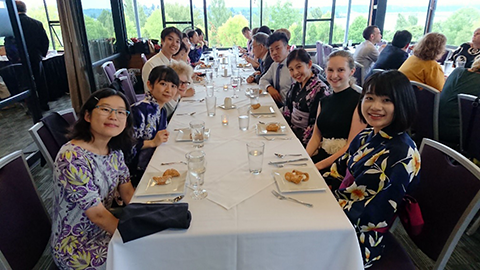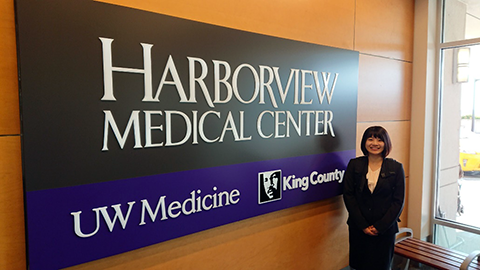国際・国内交流
大城 葵さん(第5学年次)
ワシントン大学での研修を終えて
今回私は、ワシントン大学医学部生命倫理プログラムに参加させていただきました。私がこのプログラムに参加しようと思ったのは、4年次の授業でChaplainについて、King先生に聞いたことがきっかけです。日本になじみのない職種だったので、どのように現場で生かされているのか気になりました。そのとき、このプログラムがあることを知り、ぜひ参加したいと思いました。また、私はジェネラリストに興味があります。ジェネラリストは、スペシャリストに比べて、その人の人生に向き合う場面がより多いと思います。よって、Bioethicsはとても大事になります。このような理由で私はこのプログラムに参加しました。大変貴重な経験をたくさんさせていただきましたが、その中で特に印象に残ったことを報告させていただきます。
まず、Dr.McCormickによるfour box methodについてです。先輩方に聞いたことがあり何かと気になっていました。この4日間のどの講義でも何度も出てきたので、それだけ基本となる考え方、思考プロセスであるようです。これは、1 Medical Indication for intervention (医学的適応)、2 Preference of the Patient (患者の意向)、3 Quality of Life(生活の質)、4 Contextual Issues (患者背景)からなります。1人の患者にじっくり向き合う上で、このような土台があればBioethicsという掴みづらい内容も、考えやすく、捉えやすくなると思いました。しかし、実臨床でどのくらいの割合、four box methodを使っているのか聞くと、ほとんど使われていないようでした。強いて言うならば、慢性疾患、緩和ケアなど、じっくりその人に向き合う現場では、急性期の現場よりは使われていそうだという印象を受けました。
同じ日の2コマ目に小児科の生命倫理を学びました。小児科の生命倫理という独立した考えがあることに驚きましたが、小児は個人の判断能力が確立されていないと考えられるため、このような分野が発達しているそうです。小児科の生命倫理に関する公式のホームページも作成されていて、日本より進んでいると感じました。また、アメリカでは、Bioethicsがひとつのキャリアとして捉えられています。これについても、日本より進んでいると感じました。この講義では、はっとさせられることが多く、常に頭を動かして考えていたので、終わった時にとても疲れました。新生児の蘇生をするのに、妊娠20週なら行わず、40週なら行います。これは、慣例というか、feelingでその通りだと思いました。では、24週ならどうするか、なぜそう考えるのかと聞かれたとき、答えが出ませんでした。救急の現場でじっくり考えたり話し合ったりする時間はないので、今回考えることができてよかったです。医療者として、人として、目の前に苦しんでいる人がいたら、助けるのが当たり前です。でも、その当たり前とは何でしょうか。誰が決めたのでしょうか。先ほどの事例ですが、もし、妊娠24週6日で蘇生させられなかったという経験を持つ医療者だったとしたら、24週なら助けられる、という考えはしないのではないか、23週5日ではだめなのか…。このようにたくさん設定を変えて、どのように考えるか、なぜそう考えるか議論しましょうと言われ、頭をフル回転させても“答え”が出ず、Bioethicsの奥深さ、難しさを感じました。もし、妊娠しているお腹の中の子が、ダウン症の子どもだったら、親の考えは先ほどと変わるでしょうか、と聞かれたとき、学生はみな、変わります、と答えました。それはfeelingで感じるし、日本でも問題となっていると学んだことがあったからです。では、これをfour box methodにあてはめて考えるとどうなるでしょうか。1 Medical Indication for intervention (医学的適応)と2 Preference of the Patient (患者の意向)が対立することがあります。もし、医学的適応があったとしても、胎内の子、本人の意向は聞けないので、親の意向が反映されます。この時、親や社会は子どもに対して責任があります。その責任というのは、ガイドライン・慣例として診療方針を一応一律に定めておくことも含まれます。これがなければ、実臨床では混沌とした事態となってしまうでしょう。アメリカで、この場合のガイドラインが作られるきっかけとなったのは、40年前の判例だそうです。その判例は、大きな問題として取り上げられ、全米で議論が巻き起こったそうです。そして、ガイドラインが作成されました。私は、ガイドラインというのは、たくさんの論文やエビデンスレベルに基づいてじっくり作成されるという印象がありました。時代は違いますが、こういった点からも、アメリカは変化に柔軟で、だからBioethics分野も発展が早いと感じました。ひとつの判例が、制度を作り、また制度を変えることがあると学んだ講義でした。私は人の流れや、公衆の衛生学、疫学といった分野にも興味があります。社会保険ははじめにドイツで発達しました。Doctor assisted deathはヨーロッパではじまりました。様々な背景から様々な制度が生まれます。今までは制度をそういうものだ、それに従う、という風にしか捉えていませんでしたが、このように歴史を知り、背景を知り、それが発達してきた経緯を知ることは、とても大切だと感じました。
2日目の1コマ目に、生命倫理の概念、定義を確認し、法律と絡めて社会、患者、医師の業務など多くに対して責任を持つ医師として仕事をしていく中でのBioethicsについて学びました。とても抽象的で難しかったですが、気づかされることが多かったです。最大多数の最大幸福は、一般的に“徳”とされることが多いけれど、ケースバイケースで業務にあたる医師という職業で、一般的とか最大多数、最大幸福といった考え方はしにくいです。患者に対して、他の人もこうしていますよ、という言い方はあまり適切ではないように感じました。また、90%の割合で手術は成功しますが、中にはこのような副作用が出る場合もあります。という言い方は、必ず伝えなければならない内容ですが、伝え方によってはあとから患者に聞いていない、と言われることもあります。最近はネットが発達しているので、患者が何らかの不満を持ちネット上にあげると、すぐに話題となってしまう時代となりました。医療者は特定され、真偽を問わずネットに書かれる時代となりました。そのような中で仕事をしていくのは楽なことではないけれど、なぜその行動をとったのか、と後で聞かれたときに答えられるように、日ごろから考えて仕事をしていきたいと思いました。
私が興味のあったFamily medicineについての講義では、日本人の先生のご活躍を見ることができました。西連寺先生は、偶然にも日本で私が勉強させていただいている家庭医の先生とお知り合いでいらして、話が弾みました。とても嬉しかったです。講義では、臨床心理士が家庭医療診療所にいて、一緒に患者を診るというのが驚きでした。今まで日本で見学した家庭医療の現場では見たことがなかったからです。その地域まるごと、人生まるごと診るというのは家庭医療の肝となる部分で、日本での家庭医療も地域によって様々なので、いつも新鮮ですが、今回アメリカの家庭医療という大変貴重な勉強ができ、大変嬉しく思います。家庭医療はより密につながることになるので、自分を守りつつ、仕事をしなければならないということは、驚きのポイントでした。
私は医療過疎地出身であり、WAAMIについての講義は大変刺激的でした。これは、ワシントン大学が1971年から行っているプログラムで、日本での地域枠入試制度と似ているところがあります。設立の目的は地方に医師を供給し、医療過疎地域の医療制度の確立をはかることでした。日本の地域枠制度は入学前後の交流会や小規模の学習会などはあります。WAAMIには、医師としてその地域で働くために、より多くの、よりその地域に根差したプログラムが組まれていました。入試には各州でつくる入学委員会があり、そこの医師たちによって審査されます。1974年には少ししか関連施設がなく、あまり科・分野も多くありませんでしたが、2018年には地図が関連施設で埋め尽くされるほどであり、多くの研修プログラムが組まれていました。制度というのは、研究と一緒で、すぐに成果が出るわけではないし、結果がすぐ出るものではありません。これは、医療過疎地域に地域医療に対して積極的な医師を供給することができるようになった成功例ですが、日本の制度では、成功例はあまり多くはないと思います。どのように取り組めばいいのか、まだわかりませんが、ひとりでできることではないと思うので、たくさんの人と知り合って、たくさん意見交換をして、より素敵な日本の医療になるよう、働いていきたいと思いました。
どの講義も魅力にあふれていて、ここでは紹介しきれませんが、この1週間は必ず私にとってプラスになると確信しています。私は、講義以外の場所では積極的に英語で会話をしました。私の英語は拙いものですが、皆とても優しく、一生懸命聞いてくださり、答えてくださるのがとても嬉しかったです。多くの出会いに感謝しています。シアトルはとても素敵な街で、観光もとても楽しかったです。クルージングやStarbucksめぐりなど人生でこれ以上ない経験をたくさんさせていただきました。本当にありがとうございました。
最後になりましたが、このような素敵な機会を与えてくださった、枚方療育園の山西先生をはじめ、今回の研修でお世話になった関先生、蒲生先生、近藤先生、中村先生、櫻井さん、梅澤さん、ガイドのよしこさん、通訳のTuridさん、ワシントン大学のMcCormick先生、King先生、素晴らしい講義をしてくださった多くの先生方、学生の皆、心より感謝申し上げます。本当にありがとうございました。

